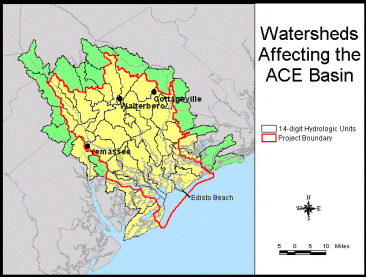Characterization of the Ashepoo-Combahee-Edisto (ACE) Basin, South Carolina
The ACE Basin Characterization Study is a joint effort between the SCDNR and the National Oceanic and Atmospheric Administration's Coastal Services Center (NOAA CSC), with contributions from numerous other agencies. The study was developed to provide agencies, land managers, resource managers, conservation groups, scientists, and private citizens with an interdisciplinary synthesis of information about this ecologically important area of South Carolina. In particular, this study was designed to present technical information in a format that is understandable to resource managers and educators. The primary goal is to facilitate management and resource allocation in the ACE Basin and surrounding areas by assembling into one information resource much of the environmental, socioeconomic, and resource management information necessary to make cogent decisions. A major emphasis of the ACE Basin Ecological Characterization is to explore the linkages between land use within a watershed and the ecological and sociological changes that result.

The ACE Basin Characterization study area consists of approximately 320,000 ha (790,000 ac) and extends approximately 72 km (45 mi.) in a northwest to southeast orientation with an approximate width of 40 km (25 mi). The study area encompasses the Ashepoo, Combahee, and Edisto River basins from the Atlantic Ocean upstream to approximately 8-11 km (5-7 mi) northwest of Walterboro with portions located in Colleton, Charleston, Beaufort, and Hampton Counties. The boundaries of the study area are primarily based on Natural Resource Conservation Service hydrologic units or watersheds. This use of watershed units to define boundaries is consistent with an ecosystem approach to resource management and reduces emphasis on political boundaries such as those used to define cities or counties. Management activities that are planned and implemented from an ecosystem and watershed perspective are much more effective in protecting and restoring habitats and resources than strategies that are isolated from the watershed approach (Shabman, 1996).
Over the last 20 to 30 years, scientists and resource managers have begun to combine a wide variety of once independent disciplines into concepts of landscape ecology, ecosystem evaluation, and integrated resource management (Kineman and Parks 1996). Using this approach, habitats are now managed as a complex, integrated system based on assorted characteristics such as sediment type, water quality, water flow, contaminants, weather patterns, and social and economic factors. The renewed interest in managing natural resources using a comprehensive ecosystem-based framework recognizes humans as a dependent and integral component of the functioning ecosystem, rather than separate and independent of it (Meffe and Carroll 1994; Kineman and Parks 1996).
